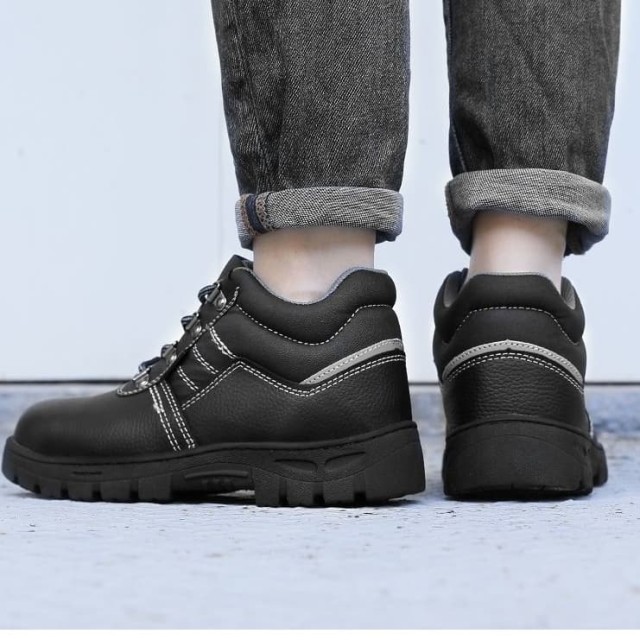Finding the right safety boots for your job isn't just about compliance—it's about comfort, protection, and performance in the specific conditions you face daily. Whether you're braving torrential rain on a construction site or navigating icy trails in forestry work, the wrong footwear can compromise safety and productivity. This guide breaks down the critical differences between weather-resistant and waterproof safety boots, helping you make an informed decision based on your occupational needs and environmental challenges.
Understanding Weather-Resistant and Waterproof Safety Boots
Not all protective footwear handles moisture the same way. The distinction between weather-resistant and waterproof designs affects durability, comfort, and long-term performance.
Key Differences in Material Technologies
- Weather-Resistant Boots: Typically use treated leather or synthetic materials that repel light rain and splashes. These rely on tight seams and hydrophobic coatings (e.g., wax or silicone) to delay water absorption but aren’t fully impervious.
- Waterproof Boots: Incorporate membranes like Gore-Tex® or proprietary laminated layers that block water penetration entirely. Sealed construction and waterproof liners prevent saturation even during prolonged exposure.
Practical Insight: Weather-resistant options suffice for intermittent moisture (e.g., morning dew or brief showers), while waterproofing is essential for sustained wet conditions like marshland work or heavy rainfall.
Industry Standards and Certifications
Safety footwear must meet rigorous testing standards. Key benchmarks include:
- ASTM F2413: Defines impact resistance, compression ratings, and metatarsal protection. Labels like "Mt" indicate metatarsal guards for heavy-object hazards.
- ASTM F2412: Governs test methods for sole puncture resistance (e.g., "PR" rating) and electrical insulation.
- CSA Z195: Canadian standards highlighting toe protection (symbolized by a green triangle) and sole puncture resistance (white label).
Compliance Tip: Look for ASTM/CSA markings on product tags. For waterproof claims, verify independent testing (e.g., "IPX" ratings for water ingress protection).
Performance Across Weather Conditions
Rain and Humidity: Limitations of Water-Resistant Leather
Weather-resistant leather boots excel in dry-to-damp conditions but have critical limitations:
- Gradual Saturation: Untreated leather absorbs moisture over time, leading to stiffening, odor buildup, and reduced insulation.
- Breathability Trade-off: Waterproof membranes can trap heat; moisture-wicking liners (e.g., Cambrelle®) mitigate this in humid environments.
Use Case: Warehouse workers in humid climates benefit from breathable, weather-resistant boots with antimicrobial treatments to combat sweat.
Extreme Wetness: How Waterproof Boots Prevent Saturation
Fully waterproof designs use:
- Seam-Sealed Construction: Prevents water seepage through stitching.
- Gusseted Tongues: Block debris and water entry at the ankle.
Field Example: Fishermen or wastewater treatment staff require knee-high waterproof boots with chemical-resistant soles (e.g., nitrile rubber).
Cold Weather: Insulation and Traction Considerations
- Insulated Linings: Thinsulate™ or fleece retain heat without bulk.
- Outsole Design: Vibram® Arctic Grip soles maintain flexibility in sub-zero temperatures.
Pro Tip: Pair waterproof boots with thermal socks for temperatures below -20°C (-4°F).
Use Cases and Recommendations
Construction Sites: Durability vs. Water Exposure
- High-Risk Zones: Steel-toe waterproof boots (ASTM F2413-18 I/75 C/75) for rebar work in rainy climates.
- Dry Conditions: Composite-toe weather-resistant boots reduce weight for long shifts.
Outdoor Adventures: Balancing Breathability and Protection
- Hiking/Trekking: Waterproof boots with ankle support (e.g., mid-cut designs) for uneven terrain.
- Snowshoeing: Insulated models with rigid soles for binding compatibility.
Step Into Safety with 3515
Whether you’re equipping a team for harsh winters or sourcing breathable summer work boots, 3515 delivers industry-compliant footwear tailored to your environment. Our expertise spans ASTM and CSA-certified designs—from waterproof membranes for all-day dryness to lightweight composites for electrical safety.
Ready to optimize your workforce's footwear? Partner with 3515 to outfit your crew with precision-engineered safety boots that meet the demands of any job site.
Related Products
- Wholesale Customizable Suede Safety Boots - Puncture-Proof with Velcro Closure
- Wholesale Durable Breathable Safety Boots Custom OEM Manufacturer
- Customizable Anti-Smash Safety Boots for Wholesale & Private Label Manufacturing
- Athletic Safety Shoes with Dial Closure & Steel Toe for Wholesale & Custom Manufacturing
- Durable Mid-Cut Tactical Boots for Wholesale & Private Label
Related Articles
- How to Choose Work Boots That Match Your Industry's Safety Needs
- How to Choose Work Boot Materials for Maximum Safety and Durability
- How to Choose Work Boots That Balance Safety, Comfort, and Durability for Your Job
- How to Choose Work Boots That Match Your Job Demands and Safety Needs
- How Safety Work Boots Engineer Protection: Features and Standards for Targeted Hazard Mitigation



















